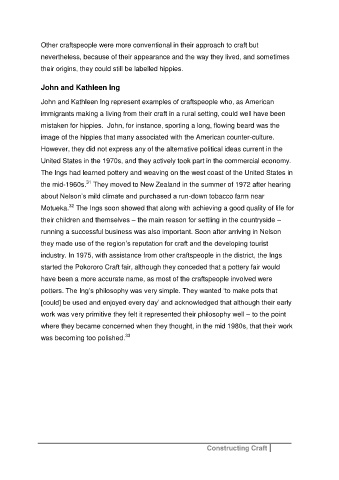Page 192 - Constructing Craft
P. 192
Other craftspeople were more conventional in their approach to craft but
nevertheless, because of their appearance and the way they lived, and sometimes
their origins, they could still be labelled hippies.
John and Kathleen Ing
John and Kathleen Ing represent examples of craftspeople who, as American
immigrants making a living from their craft in a rural setting, could well have been
mistaken for hippies. John, for instance, sporting a long, flowing beard was the
image of the hippies that many associated with the American counter-culture.
However, they did not express any of the alternative political ideas current in the
United States in the 1970s, and they actively took part in the commercial economy.
The Ings had learned pottery and weaving on the west coast of the United States in
31
the mid-1960s. They moved to New Zealand in the summer of 1972 after hearing
about Nelson’s mild climate and purchased a run-down tobacco farm near
32
Motueka. The Ings soon showed that along with achieving a good quality of life for
their children and themselves ‒ the main reason for settling in the countryside ‒
running a successful business was also important. Soon after arriving in Nelson
they made use of the region’s reputation for craft and the developing tourist
industry. In 1975, with assistance from other craftspeople in the district, the Ings
started the Pokororo Craft fair, although they conceded that a pottery fair would
have been a more accurate name, as most of the craftspeople involved were
potters. The Ing’s philosophy was very simple. They wanted ‘to make pots that
[could] be used and enjoyed every day’ and acknowledged that although their early
work was very primitive they felt it represented their philosophy well – to the point
where they became concerned when they thought, in the mid 1980s, that their work
33
was becoming too polished.
Constructing Craft

